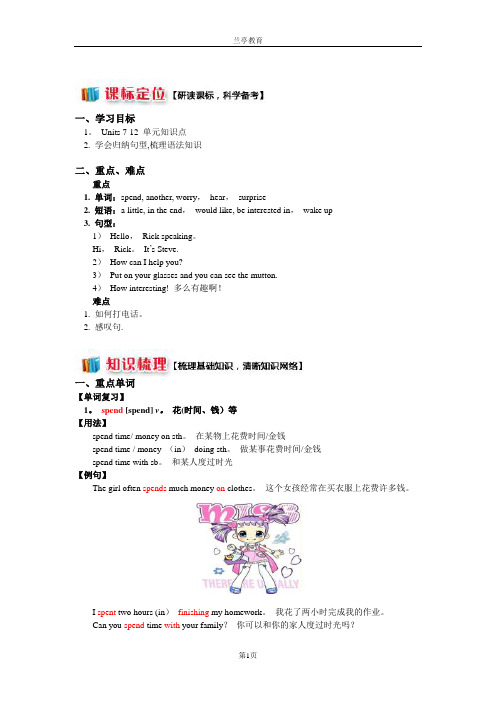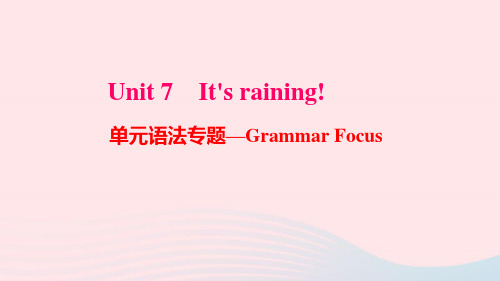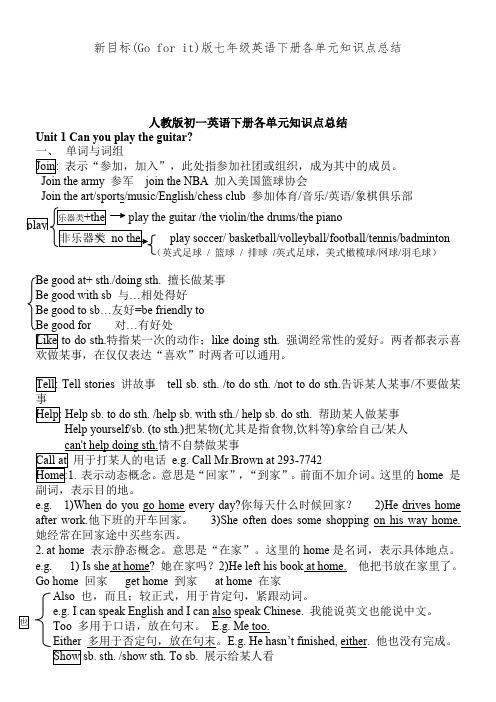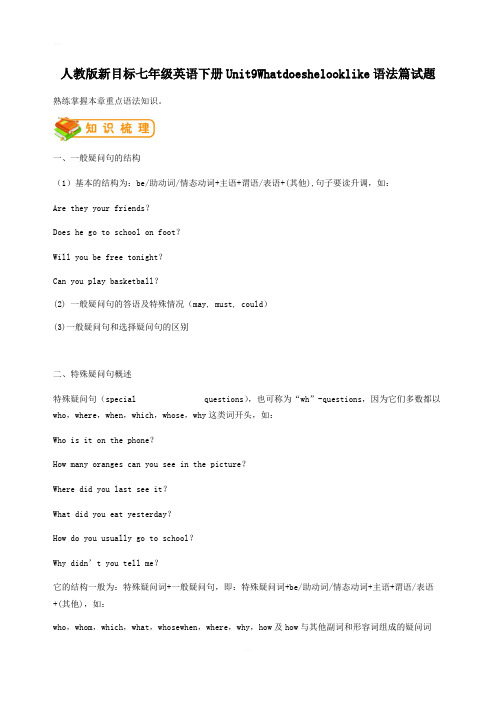人教版新目标英语七年级下册--语法
七年级英语人教版(新目标)(最新版)下学期期末复习:知识点归纳

一、学习目标1。
Units 7-12 单元知识点2. 学会归纳句型,梳理语法知识二、重点、难点重点1. 单词:spend, another, worry,hear,surprise2. 短语:a little, in the end,would like, be interested in,wake up3. 句型:1)Hello,Rick speaking。
Hi,Rick。
It’s Steve.2)How can I help you?3)Put on your glasses and you can see the mutton.4)How interesting! 多么有趣啊!难点1. 如何打电话。
2. 感叹句.一、重点单词【单词复习】1。
spend [spend] v。
花(时间、钱)等【用法】spend time/ money on sth。
在某物上花费时间/金钱spend time / money (in)doing sth。
做某事花费时间/金钱spend time with sb。
和某人度过时光【例句】The girl often spends much money on clothes。
这个女孩经常在买衣服上花费许多钱。
I spent two hours (in)finishing my homework。
我花了两小时完成我的作业。
Can you spend time with your family?你可以和你的家人度过时光吗?【拓展】(1) pay常用来表示“付款”,主语是人,其后用介词for。
sb。
pays money for sth. = sb。
spends money on/ doing sth。
(2)cost 表示“花钱”,主语为物。
sth。
costs sb. money. = sb. pays money for sth。
= sb。
spends money on/(in)doing sth。
人教版新目标七年级下册Unit1_12重点短语及句型归纳

Unit 1. Can play the guitar?重点短语重点句型1. —Can you swim?你会游泳吗?—No,I can’t.不,我不会。
2. Can you play the guitar?你会弹吉他吗?3. I want to join the art club.我想参加艺术俱乐部.4. What club do you want to join?你想参加什么俱乐部?5. You are very good at telling stories.你非常擅长讲故事。
6. Sounds good. But I like to draw,too.听起来不错。
但我也喜欢画画。
7. Then join two clubs—the story telling club and the art club!那么就请加人两个俱乐部——讲故事俱乐部和艺术俱乐部。
8. 一Can Wu Jun speak English?吴俊会讲英语吗?一No,he can’t, but he can speak Chinese.不会,但他会讲汉语。
9. Are you good with old people?你与老人们相处得融洽吗?10. Can you play the piano or the violin?你会弹钢琴还是会拉小提琴?Unit 2 What time do you go to school?重点短语重点句型1. What time do you go to school?你几点去上学?2. 一What time do you usually take a shower,Kick?瑞克,你通常几点钟淋浴?—I usually take a shower at six forty.我通常六点四十淋浴。
3. 一When do you go to work? 你什么时候去上班?一At eleven o’clock, so I’m never late for work.十一点,我上班从来没有迟到4. —What time do they get dressed?他们几点钟穿上衣服?一They always get dressed at seven twenty.他们总是七点二十穿上衣服。
人教版新目标英语七年级下册Grammar-Focus翻译

人教版新目标英语七年级下册Grammar-Focus翻译简介本文档翻译了人教版新目标英语七年级下册的Grammar Focus 部分。
该部分着重介绍了七年级学生需要掌握的语法知识和技巧。
内容Grammar-Focus部分主要包含以下内容:1. 时态:介绍了英语中的三种基本时态:一般现在时、一般过去时和一般将来时。
为了便于学生理解,每个时态都附带了常用动词的变化形式和使用方法。
2. 动词的用法:详细讲解了动词的不同用法,例如肯定句、否定句、疑问句、否定疑问句等,并给出了相应的例句和练题。
3. 名词的用法:介绍了名词的单复数形式以及所有格的用法。
通过一些实例,帮助学生掌握名词的正确用法。
4. 形容词的用法:讲解了形容词的比较级和最高级形式。
通过对比不同事物的特点,学生可以更好地理解形容词的用法。
5. 副词的用法:介绍了副词的基本用法,以及修饰形容词和副词的不同方式。
学生可以通过练加深对副词的理解。
6. 状语从句的用法:讲解了状语从句的结构和使用方法。
通过理解句子的主干和从句之间的关系,学生可以正确运用状语从句。
总结通过研究本文档中介绍的语法知识,七年级学生可以提高英语语法的掌握能力,并能够更准确地运用这些知识来构建句子和表达自己的观点。
同时,通过练题的完成,学生可以进一步加深对所学知识的理解和应用能力。
以上是对人教版新目标英语七年级下册Grammar-Focus部分的翻译和简要介绍。
该部分涵盖了七年级学生需要掌握的主要语法知识和技巧。
通过学习和练习,学生可以提高自己的语法水平并更好地运用英语表达自己。
希望这个文档对您有所帮助!。
七年级英语下册Unit7单元语法专题_GrammarFocus作业课件新版人教新目标版

三、按要求完成下列句子。 11.How is the weather?(改为同义句) __W__h_a_t'_s _th_e_w_e_a_t_h_e_r _li_k_e__? 12.He usually plays computer games in the morning.(用now改写) He _i_s p_l_a_y_in_g___ computer games now. 13.They are watchiarents.(改为否定句) They __a_re_ n_o_t___ watching TV in the room with their parents.
14.Helen usually plays volleyball with Mike.(改为一般疑问句) _D__o_es_ Helen usually __p_la_y_ volleyball with Mike? 15.The children are doing_their_homework right now.(对画线部分 提问) W__h_a_t a_r_e_ the children _d_o_i_n_g right now?
C.is listening to a CD D.listens to a CD
( A )9.—________ you ________ English every morning? —Yes,but now I am reading Chinese. A.Do;read B.Are;read C.Are;reading D.Do;reading ( B)10.—Is it snowing in Tianjin today? —________. A.Yes,it isn't B.Yes,it is C.No,it is D.No,it doesn't
新目标(Go for it)版七年级英语下册各单元知识点总结

新目标(Go for it)版七年级英语下册各单元知识点总结人教版初一英语下册各单元知识点总结Unit 1 Can you play the guitar?一、 单词与词组表示“参加,加入”,此处指参加社团或组织,成为其中的成员。
Join the army 参军 join the NBA 加入美国篮球协会Join the art/sports/music/English/chess club 参加体育/音乐/英语/象棋俱乐部play soccer/ basketball/volleyball/football/tennis/badminton / 篮球 / 排球 /英式足球,美式橄榄球/网球/羽毛球)Be good at+ sth./doing sth. 擅长做某事Be good with sb 与…相处得好Be good to sb …友好=be friendly toBe good for 对…有好处特指某一次的动作;like doing sth. 强调经常性的爱好。
两者都表示喜讲故事 tell sb. sth. /to do sth. /not to do sth.告诉某人某事/不要做某帮助某人做某事Help yourself/sb. (to sth.)把某物(尤其是指食物,饮料等)拿给自己/某人e.g. Call Mr.Brown at 293-7742意思是“回家”,“到家”。
前面不加介词。
这里的home 是e.g. 1)When do you go home every day?你每天什么时候回家? 2)He drives home after work.他下班的开车回家。
3)She often does some shopping on his way home. 她经常在回家途中买些东西。
2. at home 表示静态概念。
意思是“在家”。
这里的home 是名词,表示具体地点。
[人教新目标版]七年级英语下册Unit1Canyouplaytheguitar语法篇试题含答案
![[人教新目标版]七年级英语下册Unit1Canyouplaytheguitar语法篇试题含答案](https://img.taocdn.com/s3/m/c93bf1dd0242a8956bece43e.png)
Unit1语法篇____________________________________________________________________________________________________________________________________________________________________学生通过本讲学习,能够掌握本单元的重点语法,并在综合能力上有一定的拓展。
一、情态动词can的基本用法情态动词can有一定的词义,但不能独立存在,它必须与动词原形一起构成谓语。
情态动词can没有人称和数的变化。
其具体用法如下:1.表示"能、会",指脑力或体力方面的"能力"。
例如:I can speak English.我会讲英语。
Jim can swim but I can't.吉姆会游泳,但我不会。
2.表示"可能",常用于否定句或疑问句中,指某种可能性。
例如:Han Mei can't be in the classroom.韩梅不可能在教室里。
Can he come here today,please?请问他今天能到这里来吗?3.表示"可以",常用于口语中,指许可或请求做某事。
例如:Can I have a cup of tea,please?请问我可以喝一杯茶吗?You can go out.你可以出去了?二、情态动词的注意事项1.can的口诀:情态动词can、can、can,动词原形跟后面。
变疑问can提前,变否定not后面加上去。
主语人称单复数,情态动词不能变。
2.情态动词can可以引导肯定句和疑问句。
(1)、肯定句:主语+can+动词原形+其他成分(2)、疑问句:can+主语+动词原形+其他成分3.can引导的肯定句变为疑问句的方法:(一调二改三问号)(1)、can提前,首字母大写。
七年级下册英语语法点总结(新目标)

七年级下册英语语法点总结Unit 1 Where’s your pen pal from?一.短语:1 .be from = come from 来自于----2.live in 居住在---3.on weekends 在周末4 .write to sb = write a letter to sb 给某人写信;写信给某人5 .in the world 在世界上in China 在中国6.pen pal 笔友14 years old 14岁favorite subject 最喜欢的科目7.the United States 美国the United Kingdom 英国New York 纽约8.speak English 讲英语like and dislike 爱憎9.go to the movies 去看电影play sports 做运动二.重点句式:1 Where’s your pen pal from? = Where does your pen pal from/2 Where does he live?3 What language(s) does he speak?4 I want a pen pal in China.5 I can speak English and a little French.6 Please write and tell me about yourself.7 Can you write to me soon?8 I like going to the movies with my friends and playing sports.三.本单元的国家,人民、语言对应。
1 Canada---- Canadian---- English / French2 France------ French------French3 Japan------Japanese----Japanese4 Australia----Australian----- English5 the United States------ American---- English6 the United Kingdom---British----- EnghishUnit 2 Where’s the post offic e?一.Asking ways: (问路)1.Where is (the nearest) ……?(最近的)……在哪里?2.Can you tell me the way to ……?你能告诉我去……的路吗?3.How can I get to ……?我怎样到达……呢?4.Is there …… near here / in the neighborhood? 附近有……吗?5.Which is the way to ……?哪条是去……的路?二.Showing the ways: (指路)1. Go straight down / along this street. 沿着这条街一直走。
人教版新目标七年级英语下册Unit9Whatdoeshelooklike语法篇试题含答案

人教版新目标七年级英语下册Unit9Whatdoeshelooklike语法篇试题熟练掌握本章重点语法知识。
一、一般疑问句的结构(1)基本的结构为:be/助动词/情态动词+主语+谓语/表语+(其他),句子要读升调,如:Are they your friends?Does he go to school on foot?Will you be free tonight?Can you play basketball?(2) 一般疑问句的答语及特殊情况(may, must, could)(3)一般疑问句和选择疑问句的区别二、特殊疑问句概述特殊疑问句(special questions),也可称为“wh”-questions,因为它们多数都以who,where,when,which,whose,why这类词开头,如:Who is it on the phone?How many oranges can you see in the picture?Where did you last see it?What did you eat yesterday?How do you usually go to school?Why didn’t you tell me?它的结构一般为:特殊疑问词+一般疑问句,即:特殊疑问词+be/助动词/情态动词+主语+谓语/表语+(其他),如:who,whom,which,what,whosewhen,where,why,how及how与其他副词和形容词组成的疑问词what time, how long, how soon, how often, how old, how far, how many, how much一、单选1.【重庆市2015年初中毕业暨高中招生考试英语试题(A卷)】–_____ did you work out theproblem in such a short time? --With Mr. Li’s help.A. WhenB. WhereC. HowD. Which2. 【重庆市2015年初中毕业暨高中招生考试英语试题(A卷)】—_____ does your father go to the fitness center?—He exercises there twice a week.A. How soonB.How oftenC. How long3.【四川省资阳市2015年中考英语试题】—Excuse me, madam. Could you please tell me_________ the bus arrives?—Sure. At 9:00.A. whereB. whenC. whyD. how4. 【上海市2015年中考英语试题】 --______ father took part in the charity activity in the neighbourhood yesterday ?-- Peter’sA .WhoseB .What C. Which D. Who5.【贵州省铜仁市2015年中考英语试题】 —__________ is it from your home to school? —It’s about 2 kilometers.A.How longB.How farC. How soonD. How often解析:1.根据回答可知问的是怎么样作出这么问题,故选C。
- 1、下载文档前请自行甄别文档内容的完整性,平台不提供额外的编辑、内容补充、找答案等附加服务。
- 2、"仅部分预览"的文档,不可在线预览部分如存在完整性等问题,可反馈申请退款(可完整预览的文档不适用该条件!)。
- 3、如文档侵犯您的权益,请联系客服反馈,我们会尽快为您处理(人工客服工作时间:9:00-18:30)。
人教版新目标英语七年级下册――语法ESTO-ENGLISH 75134-75142可数名词的单数变复数规则(规则变化):①绝大多数名词的复数形式是在名词词尾加s ,例如bag—bags,apple-apples; ②以辅音字母+y 结尾的名词,先变y 为i ,再加es 。
例如:family- families ,dictionary- dictionaries ; ③在以s ,sh ,ch ,x 结尾的名词后加es 。
例如:Class- Classes ,watch (手表)-watc hes ;④在以f 或fe 结尾的名词,变f 或fe 为ves 。
例如:wife-wives ,leaf-leaves ;⑤以o 结尾的名词,有生命的加s ,没有生命的加es 。
例如:piano-pianos ,tomato-tomatoes ,zoo-zoos 。
可数名词的单数变复数(不规则变化):man-men ;woman-women ;child-children ;chinese- chinese ;Japanese- Japanese一般现在时用法:(1)一般现在时表示经常的或习惯性的动作,或存在的状态。
例如:①I am a student.我是一个学生。
(存在的状态)②He likes .apples.他喜欢苹果。
③She has a bike.她有一辆自行车。
这些动词常与often,usually,always,every day/morning/week/month/year…,sometimes(有时),on Sundays,never(从不,从来没有),once a week(每周一次)等连用。
例如:④I go to school every day.我每天去上学。
⑤He doesn't work on Sundays.他星期天不工作。
(2)表示普遍真理或客观事实。
例如: ① It is hot in summer.夏天天气热。
(普遍真理/客观事实) ②There is a big tree near the house.房子附近有一棵大树。
(客观事实)③The sun rises .(v, 升起)in the east.太阳从东方升起。
(普遍真理) (3)表示主语的特征、性格、状态或能力等。
例如:①He is at work now.他现在在工作。
(表示主语的状态)②Do you speak English?你会讲英语吗?(表示主语的能力)③I like swimming.我喜欢游泳。
(表示主语的喜好)(4)表示计划、安排的将来动作,也可用一般现在时。
如go,come,leave,arrive, be,start,begin 等动词常可以这样使用。
例如:①She comes .back tonight.她今晚回来。
(现在还未到晚上,她还未回来) ②The metting is at 8:30,don't be late .八点钟开会,别迟到。
(会还未开,还没有迟到)构成:一般现在时由“主语+动词”构成。
根据我们的学习内容,把动词分为三类—系动词be (即is ,am ,are ),have \has (意思为有,吃...等)和实义动词....(表示人或动物动作的动词,即行为动词....)。
下面分类讲述三类动词的一般现在时。
(1)系动词be (即is ,am ,are )的一般现在时Be 的用法:动词除第一人称单数(即I)用am ,第三人称单数......用is 外,其余一律用are 。
肯定句由“主语+be (is ╱am ╱are )+其他”构成。
例如:①I am a boy.我是男孩。
②She is from Japan.她来自日本。
③They are students.他们是学生。
肯定句变成否定句只需在be 后加not 既可。
(is not =isn't,are not=aren't)以上三句的否定句依次为: ① I am not a boy.我不是男孩。
② ②She isn't from Japan.她不是来自日本。
③They aren't students.他们不是学生。
肯定句变成一般疑问句只需把系动词be (即is ,am ,are )提到句子前面即可(注意:肯定句中的I ,we 需要变成you ;my ,our 需要变成your )。
所以以上三句的一般疑问句形式依次为:①Are you a boy ?Yes ,I am .No,I'm not.②Is she from Japan? Yes,she is.No,she isn't .③Are they students? Yes,they are. No,they aren't .(2)have \has (意思为有,吃...等) 肯定句由“主语+have \has +其他”构成。
(注意:第三人称单数使用has ,其余一律用have )例如: ①She has a new pen.她有一枝新钢笔 ②They have lunch at home.他们在家吃午饭。
③I have a brother.我有一个弟弟。
肯定句变成否定句需要用助动词don't/doesn't ,即由“主语+don't/doesn't+have +其他”构成。
(do not =don't,does not=doesn't)以上三句的否定句依次为:①She doesn't have a new pen.她没有一枝新钢笔。
②T hey don't have lunch at home.他们不在家吃午饭。
③I don't have a brother.我没有一个弟弟。
肯定句变成一般疑问句需要用助动词do/does ,即一般疑问句为“Do/Does+主语+have +其他”。
所以以上三句的一般疑问句形式依次为:① Does s hehave a new pen她有一枝新钢笔吗? Yes ,she does./No,she doesn't . ②Do they have lun at home ?他们在家吃午饭吗?Yes ,theydo./No,they don't. ③Do you have a brother ?你有一个弟弟吗?Yes ,I do./No,I don't. (.3.)实义动词.....(表示人或动物动作的动词即行为动词....)的一般现在时 肯定句由“主语+动词原形(s/es)”构成。
(注意:只有在主语为第三人称单数的情况下,动词原形后面才加s/es)。
例如:①I do homework every day.我每天都做作业。
②He watches ..TV every evening.他每晚都看电视。
肯定句变成否定句需要用助动词don't/doesn't ,即由“主语+don't/doesn't+动词原形”构成。
以上三句的否定句依次为:①Idon't do homework every day.我每天不做作业。
②He doesn't watch TV every evening.他每晚不看电视。
肯定句变成一般疑问句需要用助动词do/does ,即一般疑问句为“Do/Does +主语+动词原形”。
所以以上三句的一般疑问句形式依次为:①Do you do homework every day ?你每天都做作业吗?Yes ,I do./No,I don't.②Does he watch TV every evening ?他每晚都看电视吗?Yes ,she does.No,she doesn't .七年级英语下册第一单元Unit 1 Where is your pal from?国家与语言(熟悉内容):China – Chinese (汉语,中国人) England – English Canada – Canadian (加拿大人) France – French (法语,法国人)America – American (美国人)Japan – Japanese (日语,日本人) Australia – Australian (澳大利亚人)(p1)be from =come from 来自Linda is from Japan.= Linda comes.from Japan.那么Where's your pen pal from?= ?(p2)live住,居住(后跟地点是常用live in) 。
例如:I live in China. Do you live in China? Yes,Ido.No,Idon't.I don'tlive in China. Where do you live? (where 是副词,和动词live搭配时,动词后不能加介词in)His aunt lives in Sydney.Does his aunt live in Sydney?Yes,shedoes.No,shedoesn't . His auntdoesn't live in Sydney. Where does His aunt live?(p3)说某种语言用speak, speak Chinese/ English / Japanese / French 说汉语/英语/日语/法语问某人说某种语言用句型What language do/does sb speak?What language do you speak?I speak Chinese.What language does Mary speak?She speaks English .(p5,3a)14 years old 14岁解释:数字+ year(s)old …岁当数字大于1时,year用复数years。
I am 30 years old. Her son is 1 year old.(p5,3a)can为情态动词,“能,能够,会”。
后面跟动词时必须用动词原形。
肯定句变成一般疑问句需把can提到句首。
肯定句变成否定句只需把can变成can't 既可。
例如:She can speak English. Can she speak English? Yes,shecan.No,shecan't .She can't speak English.(p5,3a)“Like+动词ing”表示“喜欢做某事”I like playing basketball.Tom likes listening to music.注意:“Like+to+动词”也表示“喜欢做某事”,只是“Like+动词ing”表示习惯性动作(也可以说是爱好),而“Like+to+动词”表示一次性或短暂性的。
